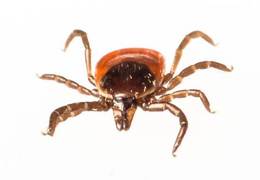 Summer is a wonderful season here in the northeast US, but there is a dark side - ticks. Tick numbers, types of ticks, and diseases (including Lyme disease) that people are getting from tick bites are all increasing. Nothing seems to stop their spread and their increasing numbers. But what if a fungus that kills ticks is the answer? The fungus is Metarhizium anisopliae, which occurs naturally in forest soils. It is sold as Met52 - a non-toxic to humans and pets product that anyone can now purchase.
Summer is a wonderful season here in the northeast US, but there is a dark side - ticks. Tick numbers, types of ticks, and diseases (including Lyme disease) that people are getting from tick bites are all increasing. Nothing seems to stop their spread and their increasing numbers. But what if a fungus that kills ticks is the answer? The fungus is Metarhizium anisopliae, which occurs naturally in forest soils. It is sold as Met52 - a non-toxic to humans and pets product that anyone can now purchase.
The product is now being tested in a multiyear study (led by R. Ostfeld & F. Keesing) in 24 neighborhoods with a high incidence of Lyme disease in New York state. Studies show that ticks die within 3 to 7 days after being exposed to Met52 (a spray made up of the fungal spores and water). Personally, I am very excited by this natural product and hope that it works well. The researchers are hoping for a 90% reduction of ticks (or more!) in areas and yards where it is applied! That is better control than the insecticides typically used. The researchers feel that if this works well, then municipalities or neighborhoods could do it on a large scale for tick control.
I first read about the study in this July 2018 article by M. Molteni in Wired: WE HAVE NO IDEA HOW BAD THE US TICK PROBLEM IS
Together, these efforts are helping to change the way people and government agencies think about ticks as a public health threat. ...The trouble is that scientists also know very little about which interventions actually reduce those risks. “There’s no shortage of products to control ticks,” says Ostfeld. “But it’s never been demonstrated that they do a good enough job, deployed in the right places, to prevent any cases of tick-borne disease.” In a double-blind trial published in 2016, CDC researchers treated some yards with insecticides and others with a placebo. The treated yards knocked back tick numbers by 63 percent, but families living in the treated homes were still just as likely to be diagnosed with Lyme.
Ostfeld and his wife and research partner Felicia Keesing are in the middle of a four-year study to evaluate the efficacy of two tick-control methods in their home territory of Dutchess County, an area with one of the country’s highest rates of Lyme disease. It’s a private-public partnership between their academic institutions, the CDC, and the Steven and Alexandra Cohen Foundation, which provided a $5 million grant.
Ostfeld and Keesing are blanketing entire neighborhoods in either a natural fungus-based spray (MET52) or tick boxes, or both. The tick boxes attract small mammal hosts, which get a splash of tick-killing chemicals when they venture inside. They check with all the human participants every two weeks for 10 months of the year to see if anyone’s gotten sick. By the end of 2020 the study should be able to tell them how well these methods, used together or separately on a neighborhood-wide scale, can reduce the risk of Lyme.
What is this fungus that kills ticks? The fungus is Metarhizium anisopliae , a fungus that occurs naturally in forest soils. It is in the product Met52 - a fungal spray that consists of spores of the fungus Metarhizium anisopliae mixed with water. The Met52® spray has been found to kill ticks and agricultural pests such as certain beetles and root weevils. The spray is applied to plants and the surrounding soil. When a tick comes in contact with the fungal spores, the spores stick to the tick. When the spores sprout, the fungus grows through the tick’s outer covering, killing the tick. Ticks are usually killed within 3 to 7 days of exposure to Met52® spores.
The researchers picked Met52 to test against ticks because it is considered non-toxic, and already easily available - so that people can already use it in their yards. The following statements about Met52 are from the tick study's web-site The Tick Project : "Met52® is non-toxic for infants, children, and adults, and for dogs, cats, and other mammals. The Environmental Protection Agency has determined that no harm will be caused by people eating, breathing in, or touching things containing Met52®. No toxicity or harmful effects were seen when Met52® was tested in laboratory animals. The Environmental Protection Agency has approved its use in residential areas as a bioinsecticide." The researchers hope that the fungus will kill at least 90% of ticks in the yards where it is applied.
"Testing of Met52® on various insects (e.g. honey bees, lady beetles, etc.) and earthworms demonstrated no adverse effects at concentrations exceeding the concentration used in the current study."
More from the study's web-site: The Tick Project:
Overview of the study: The Tick Project is a five-year study to determine whether neighborhood-based prevention can reduce human cases of Lyme and other tick-borne diseases. The methods we are testing are simple and safe for people, pets, and the environment.
The study is taking place in Dutchess County, New York, which is home to some of the nation’s highest rates of Lyme disease incidence. We are recruiting residents of twenty-four neighborhoods to participate in the project. Each neighborhood consists of 6-10 square blocks and roughly 100 properties.
The study will determine whether two tick control methods, used separately or together, can reduce the number of cases of Lyme disease at the neighborhood level.
Method #1. The Tick Control System®The “Tick Control System”, or TCS®, is a small box that attracts rodents. When an animal enters the box, it receives a low dose of fipronil, the active ingredient in many tick treatments used on dogs and cats. Fipronil kills ticks on animals like mice and chipmunks, which are largely responsible for infecting ticks with the Lyme bacterium.
|
Method #2. Met52® fungal sprayMetarhizium anisopliae is a fungus that occurs naturally in forest soils in eastern North America and has been shown to kill ticks. A strain of this fungus, Met52, has been developed as a commercial product. It can be sprayed on vegetation where it kills ticks looking for hosts on which to feed. |
Previous studies have found that Met52®, which contains the entomopathogenic fungus Metarhizium brunneum, is effective in reducing the abundance of Ixodes scapularis, the tick vector for the bacterium causing Lyme disease and for other tick-borne pathogens. Given widespread interest in effective, safe methods for controlling ticks, Met52 has the potential to be used at increasing scales.



How I wish I had access to the information provided here a few years ago! My mother did not, and three years ago she contracted Lyme disease. She was only diagnosed two weeks ago, so she has some pretty severe damage. You do not have to see a bullseye rash to have Lyme disease!
I know this article is a year old, but we cannot find Met52 being sold anywhere. And the one place, Ebay, that has it is selling it for over $100. What happened to this product?
It looks like the product is available online from a number of places such as Seed Ranch (Florida) and Planet Natural (in Bozeman MT). Currently it is usually advertised and is sold for other pests such as certain beetles and root weevils, and not for ticks. Seed Ranch does mention ticks and how this is a good Integrated Pest Management (IPM) product.(Yes, it is!) The main thing is that the product purchased contains the fungus Metarhizium anisopliae.
The other issue is that since The Tick Project is applying it all over a property, it might be something that a homeowner would have a commercial applicator do.